Talk:Earthquake engineering/Archive 1
| This is an archive of past discussions. Do not edit the contents of this page. If you wish to start a new discussion or revive an old one, please do so on the current talk page. |
| Archive 1 |
Earthquake engineering / seismic analysis / seismic performance
Wikipedia's content on earthquake engineering is currently a bit of a mess. I am going to try to clear it up (but it might take me a while). Earthquake engineering includes analysis and design. Currently there is a reasonably decent article on analysis, and several articles on design which all seem to push the same approach and one product in particular (Earthquake Performance Evalunation Tool).
I have created this as a separate article, and propose to merge several articles into this one so that there is one clear and concise article on earthquake engineering. The Seismic analysis article can then remain as a more detailed article on analysis, which is probably the largest single topic.Tkn20 (talk) 10:51, 1 June 2008 (UTC)
Merger Proposal
I propose to merge:
- Seismic performance
- Vibration control
- Earthquake construction
- Earthquake Performance Evaluation Tool
- Earthquake Protector
- Earthquake simulation
into this article. The last three are in my opinion just adverts for particular products, and may be original research (so there is little to merge, but some of the content would be relevant when included with other available research and products). This is a big topic, covered very badly with several articles giving only a tiny view of the whole. The best thing to do is to start with a good overall article.
In the case of vibration control - there is perhaps a good argument to keep a vibration control article, but it shouldn't be primarily about earthquake vibration as it currently is. Vibration is caused in machines, by pedestrians, cars, wind and all sorts of other causes. The vibration control article should be much more general, and the earthquake specifics merged into this article. Tkn20 (talk) 10:56, 1 June 2008 (UTC)
Article Earthquake engineering now contains all basic information from six (6) articles recommended for merging which should be redirected to the following sections and subsections of Earthquake engineering:
- Seismic performance to 1 Seismic performance
- Seismic Performance Evaluation Tool to 1.1 Seismic performance evaluation
- Earthquake simulation to 2.2 Earthquake simulation
- Vibration control to 3 Seismic vibration control
- Earthquake Protector to 3.1 Earthquake protector
- Earthquake construction to 5 Earthquake construction
Shustov (talk) 22:12, 25 June 2008 (UTC)
list in intro
It does not bother me much, but is there a reason for the list of "main objectives of earthquake engineering" in the into is presented in list form, rather than prose? It's not hideous, but does not seem necessary. WP:EMBED perhaps has some insight? Again, not a huge deal to me, just seems like it might be better. ./zro (⠠⠵) 05:08, 23 December 2008 (UTC)
If it does not bother you too much, why should we scratch it? Anyway, the list format of presenting the main objectives of earthquake engineering seems to me more visual, easy for viewing and, therefore, should be preferred where appropriate. Best, Shustov (talk) 09:12, 23 December 2008 (UTC)
- Shustov, please remember that the Wikipedia Manual of Style is what we are using to write the article. If you were a newspaper reporter, you employer would tell you to author articles according to a manual of style (to either the AP Stylebook or the New York Time MOS). Likewise, Wikipedia has developed a Manual of Style, and so all articles must be compared to that. This is important to note because part of the determination if the article achieves good article (
 ) or featured article (
) or featured article ( ) status is how well it meets the Manual of Style.
) status is how well it meets the Manual of Style. - While the embedded list guideline from the MOS only says that prose should be over used embedded lists, it does not disallow the lists. However, I see that there are currently another nine embedded lists elsewhere in the article. This would not be the occasional use described in the guideline.
- Between the embedded list guideline and the lead section guideline, I would consider the article to better meet the MOS without the list in the lead section. The article is not likely to achieve good or featured status with the lead written the way it is. - ¢Spender1983 (talk) 16:55, 4 January 2009 (UTC)
Plagiarism
It looks like there are blocks of text in this article which are word-for-word copies of outside works. In Earthquake engineering#Failure modes, a number of the image captions are drawn directly from USGS documents (e.g. [2]) without attribution. (That section needs some cleanup in any case.) Footnotes, people! TenOfAllTrades(talk) 15:28, 28 December 2008 (UTC)
- Dear TenOfAllTrades: Though you, according to your User resume, are "intimately acquainted with the use of semicolons", please, think twice before accusing me in plagiarism in Earthquake engineering. All images in this article - among them there are 12 of my own - have been properly credited. In particular, of 14 images from the section Earthquake engineering#Failure modes, 7 were diligently credited to USGS (to verify, just click on the pictures!). Besides, I provided an external link to USGS site, see USGS Earthquake Hazards Program. Keep clear! Shustov (talk) 10:10, 30 December 2008 (UTC)
- Shustov, it may be that you're unfamiliar with the normal rules and standards for citations in scholarly works. While I'm sure that you're doing so unintentionally, breaking those rules is plagiarism, and is something that has to be taken very seriously. Let me try to give you a condensed quick reference guide to how you can avoid problems in the future (and how you can fix the text you've already added).
- When you copy a source word-for-word, it is essential that you do two things. You must enclose the copied material in double quotations marks: "like this". It should be absolutely clear which text you wrote yourself, and which text came from another author. Second, you need to clearly identify the source for any material which you've copied. Every quoted passage needs to have a citation identifying its source. (See Wikipedia:Citing sources#When quoting someone.)
- It isn't sufficient to include a single link in the Bibliography or External Links section. That doesn't tell our reader which text was not written by Wikipedia editors, and so fails to give credit where it is due. It also doesn't allow anyone to come back and verify the correctness of the quotations; no one knows what content from the article – if any – is drawn from any particular linked page. Finally, the particular link that you've given above only links to a large directory of additional documents and resources. While it may be a valuable resource suitable for inclusion in the list of External Links, it doesn't contain the text that was copied, again making it difficult to locate the original source of the material.
- For the USGS images which you've uploaded, yes — you have given appropriate credit on the image description pages. In the future, there are some additional tricks which you (and other Wikipedia editors) might find useful. There's a number of things you can add to the image description page.
- You can include a link (URL) for the online source of the image. Not only does that make it easy for subsequent editors to verify the source, it may also provide a useful resource to future editors.
- For images which are part of a larger document, including full publication details (title, author(s), date, etc.) can be helpful. Links to online documents are again helpful.
- For public domain technical images which are captioned, consider copying the caption in its entirety on to the image description page. (Citation rules apply there as everywhere else, so be sure to enclose the caption in "double quotes" and indicate explicitly the source.) Feel free to add additional descriptive material as appropriate.
- I hope that you find some of that guidance worthwhile, and that you can use it to fix up your contributions. TenOfAllTrades(talk) 14:24, 30 December 2008 (UTC)
Dear TenOfAllTrades: you persistently demonstrate obsession with the fixed idea of my plagiarism in the article Earthquake engineering. Unfortunately, I am a Doctor in earthquake engineering and not in medicine. However, if you wish to recover soon, please, try the following:
- Forget about earthquake engineering for a while, relax and take a deep breath.
- Try to recollect something nice and very simple: e.g., that you are "intimately acquainted with the use of semicolons" (citation from your User resume).
- Then, to warm up, do a few of my lovely sit-ups like this: File:UPSTREAM FITNESS-1.jpg.
- Most likely, after you went through the previous step, "you need to clean up after yourself" (citation from your talk on Earthquake engineering of 01:34, 30 December 2008 (UTC)).
If you are still warm and looking forward to accuse me in stealing “blocks of text which are direct copies of USGS documents” (citation from your talk on Earthquake engineering of 16:46, 29 December 2008 (UTC)), please, be advised that USGS, according to its mission statement (see USGS#Mission), is the agency which stays far away from the field of Earthquake engineering and, therefore, there is nothing valuable for me to steal from them. You may, also, compare the Categories for USGS and Earthquake engineering articles: absolutely no correlation! Due to this, your allegation that “a number of the image captions are drawn directly from USGS documents (e.g. [3]) without attribution” (citation from your talk on Earthquake engineering of 15:28, 28 December 2008 (UTC)) holds no water. Again, as I stated before, of the total of 14 images from the section Earthquake engineering#Failure modes, 7 were diligently credited to USGS (to verify, just click on the pictures!). Besides, I provided an external link to USGS site, see USGS Earthquake Hazards Program (talk of 10:10, 30 December 2008 (UTC)). By the way, I do not have any exclusive rights for editing Earthquake engineering. If anybody feels able to do the job, pull up your panties and go ahead! My best New Year wishes to all Wikipedians! Shustov (talk) 03:25, 31 December 2008 (UTC)
- So far, I've only looked at the section on 'failure modes'. I'm moving the bulk of the section to this talk page (below) and I hope that someone can fix it up – making appropriate use of quotation marks and footnotes, and paraphrasing and summarizing as necessary – before it goes back into the article. (While portions of the text here may be original, leaving those fragments in the article would be confusing.)
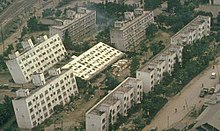
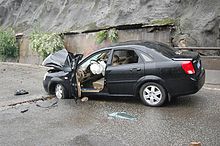
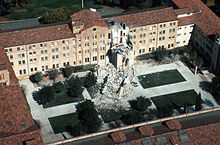
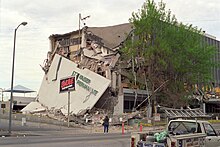
- Improper construction site
- Poor detailing of the reinforcement ( lack of concrete confinement in the columns and at the beam-column joints, inadequate splice length)
- Weak/soft story (open space at the first floors)
- Long cantilevers with heavy load

If a superstructure is not mounted on a base isolation system, its shifting on the basement should be prevented.




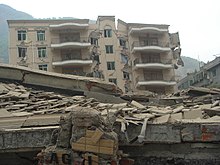

- As I noted above, the block of text appears to be mostly image captions copied from this USGS report. Someone with advanced Google skills may want to look for the report in a prettier format. TenOfAllTrades(talk) 15:04, 31 December 2008 (UTC)
- I have again removed the block of copied text. Please don't restore it to the article until the quotations are clearly marked (with "double quotes") and footnoted, or the passages are paraphrased (and footnoted). Shustov, while the images in the article have correct source information on their description pages, the article text does not. Until that text – which contains many blocks of material drawn verbatim from USGS sources – is corrected, it can't go back in the article. TenOfAllTrades(talk) 19:24, 31 December 2008 (UTC)
USGS-authored text is in the public domain. See http://www.usgs.gov/laws/info_policies.html. I don't think there is a substantial copyright issue here with the text. Tim Pierce (talk) 18:37, 1 January 2009 (UTC)
- I fully agree that there's no copyright issue. The problem is one of plagiarism — in this case, verbatim copying of blocks of text without giving credit to the source. That's why I don't see a problem with restoring the material to the article after the copied bits are clearly identified as such. TenOfAllTrades(talk) 19:01, 1 January 2009 (UTC)
You have no case, sorry! It is not enough just to pronounce a copyright violation: you have a burden of proof of your complaint yet. By the way, copyright infringement is not plagiarism! Your accusation in my alleged plagiarism from USGS unidentified source reminds me George W. Bush’s accusation of Iraq in hiding its weapon of mass destruction. Provide facts, and I will be the fist to insert the references. Again, keep in mind that plagiarism is the use or close imitation of the language and thoughts of another author and the representation of them as one's own original work. On the other hand, I am not the author of Earthquake engineering but the main contributor. Shustov (talk) 00:34, 2 January 2009 (UTC)
- This situation has gotten a little overheated, and the amount of text copied from the USGS appears to be quite small, but I do think it's reasonable to suggest that those quotations be clearly marked and cited, just to get past this issue. Tim Pierce (talk) 03:45, 2 January 2009 (UTC)
Comparison
- I don't know where the idea has come from that my concern has anything to do with copyright infringement. I have never mentioned copyright here or anywhere else, except to explicitly note that it is not an issue. The only concern I have serious enough to prompt me to remove the passage from the article is that large portions of that section are verbatim copies of USGS image documents (image captions, I think) that lack quotation marks or explicit identification of their sources. (From an editorial standpoint, I have a minor concern that it would be better to rewrite the USGS' reports in our own words and simply footnote the facts, but that's not something I would cut out a section over.)
- Shustov, I've provided a link to the USGS source page at least twice in this section. Alternatively, you can find other sources for the text on your own by pasting phrases into Google. I've also run across a PDF version of some of the USGS images with captions: 40 MB PDF. Compare:
- Our article:
- Soft story effect. Absence of adequate shear walls on the garage level exacerbated damage to this structure....
- USGS:
- Absence of adequate shear walls on the garage level exacerbated damage to this structure at the corner of Beach and Divisadero Streets...
- Our article:
- Our article:
- Pounding against adjacent building. This is a photograph of the collapsed five-story tower, St. Joseph's Seminary, Los Altos, California. One person working in the tower was killed.
- USGS:
- Aerial view of collapsed five-story tower, St. Joseph’s Seminary. One person working in tower was killed.
- Our article:
- Our article:
- Ground shaking triggered liquefaction in a subsurface layer of sand, producing differential lateral and vertical movement in a overlying carapace of unliquified sand and silt. This mode of ground failure, termed lateral spreading, is a principal cause of liquefaction-related earthquake damage.
- USGS:
- Ground shaking triggered liquefaction in a subsurface layer of sand, producing differential lateral and vertical movement in a overlying carapace of unliquified sand and silt, which moved from right to left toward the Pajaro River. This mode of ground failure, termed “lateral spreading,” is a principal cause of liquefaction-related earthquake damage.
- Our article:
- Our article:
- The magnitude 5.9 earthquake pounded the Garvey West Apartment building in Monterey Park, California and shifted its superstructure about 10 inches to the east on its foundation.
- USGS ([8]):
- Earthquake of October 1, 1987, Whittier Narrows, California. The Garvey West Apartment building in Monterey Park (at Monterey Pass Road in Garvey) shifted about 10 inches to the east on its foundation.
- Our article:
- Other parts of the section may have been taken without proper attribution from non-USGS sources.
- Our article:
- Seismic effect of steep slope of construction site, Izmit Earthquake]]7-story reinforced concrete buildings on steep slope collapse due to the following:
- Improper construction site
- Poor detailing of the reinforcement ( lack of concrete confinement in the columns and at the beam-column joints, inadequate splice length)
- Weak/soft story (open space at the first floors)
- Long cantilevers with heavy load
- Seismic effect of steep slope of construction site, Izmit Earthquake]]7-story reinforced concrete buildings on steep slope collapse due to the following:
- Kandilli Observatory & Earthquake Research Institute [9]:
- The following can be cited as the technical causes of the observed building damages or collapses:
- Poor concrete quality
- Poor detailing of the reinforcement ( lack of concrete confinement in the columns and at the beam-column joints, inadequate splice length)
- Weak/soft story (Open space at the first floors)
- Structural alterations (added floor)
- Long cantilevers with heavy load
- Improper construction site
- The following can be cited as the technical causes of the observed building damages or collapses:
- Our article:
- There may be copyright concerns there in that last one, as it is a non-U.S.-government source. Note that this is not an exhaustive analysis of the section I removed; there may be additional unattributed copying. TenOfAllTrades(talk) 07:35, 2 January 2009 (UTC)
Situation
1. There is no copyright issue except one mentioned above. 2. There is no plagiarism issue because we are all Wikipedians and not authors (see Plagiarism). 3. Now, after TenOfAllTrades provided his comparison list, I will address it ASAP by performing the editing. Shustov (talk) 17:27, 2 January 2009 (UTC)
- In reply to User:Shustov: I am pleased to hear you will look into the material flagged by TenOfAllTrades. Before concluding that your work is immune from plagiarism issues, please read the policy section at Wikipedia:Copyright problems#Plagiarism that does not infringe copyright. A student who turned in a paper that was cribbed from the 1911 Britannica would be rightly accused of plagiarism by his teacher, though he would not be violating any copyright. EdJohnston (talk) 20:08, 2 January 2009 (UTC)
- Please remember that the list I have provided is non-exhaustive. I haven't tried feeding every phrase in the section into Google; only the first few items which looked to be 'off'. I would expect Shustov to be better able to identify passages he's taken from other sources better than I can. TenOfAllTrades(talk) 21:06, 2 January 2009 (UTC)
What is good for the article, is good for me! By the way, do not trust Google too much: if you feed Earthquake engineering there, you will not find even our article though it is viewed up to 10,000 monthly. Shustov (talk) 22:28, 2 January 2009 (UTC)
- That's true. Google obviously won't identify text copied from print documents or from web pages which haven't been indexed. Did you use any such sources when you were constructing this article? TenOfAllTrades(talk) 22:49, 2 January 2009 (UTC)
Additional serious sourcing problems
Okay, I've had a quick look at the rest of the article. Again, I don't offer any guarantee that I've found all the problems. What I have found is rather troubling. A number of other sections of this article aren't original.
In the Earthquake engineering#Research for earthquake engineering section, passages describing earthquake engineering research programs are taken from outside sources.
- Our article:
- Research for earthquake engineering incorporates both field and analytical investigation or experimentation aimed at discovery and interpretation of earthquake engineering related facts, revision of accepted theories in the light of new facts, or practical application of such new or revised theories.
- The University of California's Office of Research Administration(?)(!) [10]:
- Research: investigation or experimentation aimed at the discovery of generalizable new knowledge, the interpretation of facts, and/or the revision of accepted theories in the light of new facts; or the testing of such new or revised theories.
- Our article:
- In particular, it focuses on experimental, analytical, and computational research on design and performance enhancement of structural systems.
- NSF SSHM program description:
- The Structural Systems and Hazards Mitigation of Structures (SSHM) Program element focuses on experimental, analytical and computational research on design and performance enhancement of structural systems.
- A subsequent passage describing the NSF's HSME program does at least have a URL, but doesn't indicate which text (nearly all of it) is copied verbatim.
- Our article:
- NEES comprises a network of 15 earthquake engineering experimental equipment sites available for experimentation on-site or in the field and through telepresence. NEES equipment sites include shake-tables, geotechnical centrifuges, a tsunami wave basin, unique large-scale testing laboratory facilities, and mobile and permanently installed field equipment [11].
- NEES Cyberinfrastructure Center (NEESit) connects, via Internet2, the equipment sites as well as provides telepresence, a curated central data repository, simulation tools, and collaborative tools for facilitating on-line planning, execution, and post-processing of experiments.
- NSF NEES program description [12]:
- The NEES experimental infrastructure comprises a network of 15 earthquake engineering equipment sites, located at universities across the United States, available for testing on-site, in the field, or through telepresence. The NEES equipment sites include shake tables, geotechnical centrifuges, a tsunami wave basin, unique large-scale testing laboratories, and mobile and permanently installed field equipment. The NEES cyberinfrastructure connects the equipment sites, via Internet2, and provides data curation and a curated central data repository; telepresence; simulation, computational, data visualization, and collaborative tools; hybrid (coupled computational and physical) simulation and multi-site hybrid simulation capabilities; user support services; middleware; and a cybersecurity framework.
- Oddly enough, the URL included in our article's block of text doesn't link to the text source.
- Our article:
- Kinematic similarity is the similarity of time as well as geometry. It exists between a model and prototype when:
- the paths of moving particles are geometrically similar;
- the ratios of the velocities of particles are similar.
- Kinematic similarity is the similarity of time as well as geometry. It exists between a model and prototype when:
- University of Leeds Civil Engineering [13]:
- Kinematic similarity is the similarity of time as well as geometry. It exists between model and prototype
- If the paths of moving particles are geometrically similar
- If the rations of the velocities of particles are similar
- Kinematic similarity is the similarity of time as well as geometry. It exists between model and prototype
Portions of the section Earthquake engineering#Seismic vibration control are almost certainly a cut and paste job from a paper reference. The footnote points to a book that I can't put my hands on right now, but the same author (T.T. Soong) published an abstract which uses suspiciously similar language:
- Our article:
- active control devices are force delivery devices integrated with real-time processing sensors and evaluators/controllers within the structure and on the ground;
- Proceedings of the Second MCEER Workshop on Mitigation of Earthquake Disaster by Advanced Technologies (Medat-2) [14]:
- Active systems ... are force delivery devices integrated with real time processing evaluators or controllers and sensors within the structure.
There are more, but I'm running out of steam.
From an editorial standpoint, it's worth noting that many sections of this article are essentially direct copies of other Wikipedia articles, as well. (Compare Earthquake Protector, Vibration control, Prestressed structure with their sections in this article.) Those sections need a good dose of trimming to comply with WP:SUMMARY, if they belong here at all. TenOfAllTrades(talk) 05:28, 3 January 2009 (UTC)
Article problems
Okay, I think I've found most of the problems with this article. I've made a copy of the article at Talk:Earthquake engineering/problems. Highlighted are areas which seem to be obvious problems.
- Duplication problems, where a section of this article is essentially a complete reproduction of another Wikipedia article, are cyan.
- Plagiarism problems, where a block of text is directly copied and pasted without quotation marks (and often without citation), or where a block of text has been obviously paraphrased without proper citation, are pink.
- Shustov issues, where material has been directly copied from Shustov-affiliated web sites or publications, are green. (Further investigation reveals at least two Shustovs who work together in this field; I haven't differentiated between them, or know – or care – which is the Wikipedia editor.)
As usual, I can't guarantee that I've caught all the problems. The article is a mess from top to bottom. It's also entirely possible that sections may fall into more than one category, but I can't be bothered to muck around with double coloring.
There appears to be a whole family of articles created by Shustov which duplicate the content of portions of this article. Most refer heavily to Shustov's web site and publications. I don't know whether this article or the others came first, but the short external articles should probably be merged, while the substantial ones summarized here. In some cases, the duplication is nested a couple of articles deep. Some include:
- Earthquake performance evaluation *Which in turn is largely a promo blurb for Shustov's (now-merged) Earthquake Performance Evaluation Tool
- Seismic performance analysis
- Earthquake engineering research
- Vibration control
- Earthquake Protector *This appears to be a patented product of Shustov's work
- Prestressed structure
- Earthquake loss (found TenOfAllTrades(talk) 05:04, 7 January 2009 (UTC))
I a very concerned about the heavy reliance on a single author. This article contains at least sixteen links to Shustov's websites (URLs contain ~shustov) as well as any number of links to offsite copies of publications with which he is involved. Someone else who has some expertise in the area needs to have a look; I suspect that we may be weighting our coverage rather heavily towards one person's work. TenOfAllTrades(talk) 00:49, 4 January 2009 (UTC)
- Hi ten, I landed here from the Izmit earthquake and had been to Earthquake construction before. We should at least put a phrase at the beginning of each section that has another page saying something like. A separate page <link to separate page> exists. Since this isn't a case of a quote "Main page" we need a different text. That would reduce confusion and buy time till mergers and duplications have been sorted out. All the links from other pages also need to be cleaned up/redirected. (Lisa4edit)76.97.245.5 (talk) 06:44, 16 February 2009 (UTC)
Can every cook govern the state?
Vladimir Lenin believed it could. Apparently, some Wikipedia administrators would also love to. If not a real state, then, at least, the terra incognita of Earthquake engineering. Thus, the intermediate administrator TenOfAllTrades who, according to his background, is not legally allowed, in any form, to practice Earthquake engineering, never-the-less, keeps vigorously imposing his unprofessional judgments by mercilessly cutting the Wikipedia article on Earthquake engineering without any open discussion (6 cases of his editorial assault for 1 hour 17 minutes of 6 February 2009 only!). Will anybody cut him short, please? 69.108.101.89 (talk) 09:37, 6 February 2009 (UTC)
- In case you are affiliated with the editor mentioned in #Article problems, just above, you are invited to respond to those criticisms. Discussions on Talk pages can often lead to improving articles. Successive reverts by the same editor (with no edits by others in between) are counted as one single revert, so TenOfAllTrades did not break WP:3RR. EdJohnston (talk) 12:06, 6 February 2009 (UTC)
The criticism mentioned in #Article problems above has been duly responded; see: [15] and [16] which includes: ‘Administrative paranoia or Suspicion instead of Evidence’, ‘Earthquake Protector: false pretext for deletion’, ’George W. Housner: editorial abuse of National Medal of Science laureate’ and ‘Clear up User:Shustov of false accusations in plagiarism by User:JzG’. 69.108.101.89 (talk) 20:03, 6 February 2009 (UTC)
- Forgive me for not perceiving any actionable suggestions for improving the article. Your position is, 'Trust me, I know best.' EdJohnston (talk) 21:39, 6 February 2009 (UTC)
- 69.108 has been blocked for block evasion. From the responses here and on his talk page, it seems that he still either doesn't understand or doesn't care about Wikipedia policy or academic standards regarding plagiarism, self-promotion, and conflict of interest. Most of the so-called 'merciless cutting' represents material duplicated from other articles, unsourced statements, and (in largest part) material promoting Shustov's publications, patents, and ideas. If there is anyone who has questions regarding User:Shustov's history or my conduct, they're welcome on my talk page. Cheers, TenOfAllTrades(talk) 22:32, 6 February 2009 (UTC)
To let the he-goat into the kitchen-garden
This Russian idiom (in original: “пустить козла в огород”) is the best way to describe what’s going on in the editing of Earthquake engineering article now. The “truck farmer” there, User:Shustov, is blocked by User:TenOfAllTrades for alleged plagiarism in the section #Failure_modes. After all, that “plagiarized” section stays untouched while the well-protected goat enjoys chewing out everything of value in other sections. I wonder: is there any animal control in Wikipedia? 69.108.101.89 (talk) 21:26, 8 February 2009 (UTC)
Suggestion to evaluate the draft subsection entitled 'Earthquake protector'
Everybody knowledgeable in the science of earthquake engineering is invited to evaluate the following draft subsection of the section called Seismic vibration control and give your recommendation on whether it should be included in the article Earthquake engineering:
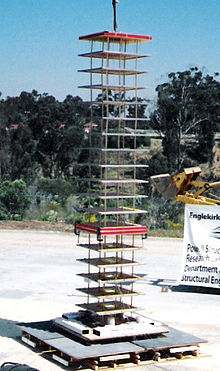
Heavy damping mechanism sometimes incorporated in vibration control technologies and, particularly, in base isolation units, may be considered a valuable source of suppressing vibrations thus enhancing a building's seismic performance. However, for the very pliant systems such as base isolated structures, with a relatively low bearing stiffness but with high damping, the so-called "damping force" may turn out the main pushing force at a strong earthquake. This finding created a theoretical ground for a damping-disengaged base isolation technology called earthquake protector.
A shake-table video of concurrent shake-table experiments with two identical and kinematically equivalent to their 12-story prototype building models is presented at [17]. The right model there rests on earthquake protectors, while the left one, caught at the time of its crash, is fixed to the shake-table platen.
Shustov (talk) 05:32, 3 June 2009 (UTC)
- You forgot to disclose your conflict of interest over this technology, as putative inventor who has filed a patent application for your 'earthquake protector'.
- Wikipedia's role is to report on existing, established knowledge, not to present and promote new ideas. Unless you can present reliable, third-party sources which support that this technology is both an important part of earthquake engineering and actually employed in the real world, its inclusion seems inappropriate in this article at this time. TenOfAllTrades(talk) 12:48, 3 June 2009 (UTC)
- I have no conflict of interest because my suggestion was addressed to "everybody knowledgeable in the science of earthquake engineering" which is not a market place. Earthquake protector as a fact of scientific research does not require to be "employed in the real world" right away. By the way, Earthquake protector neither needs an additional promotion as so far: you may try any search engine with this entry. Shustov (talk) 19:52, 3 June 2009 (UTC)
- Wikipedia doesn't report on new technologies which are only being promoted by their inventors. On Google I see a large number of pages containing your own materials, publications, patent applications, and videos, as well as mirrors of Wikipedia articles (now deleted or edited) which you wrote to publicize your invention. I don't see any substantial third-party interest in or reports on this technology, nor any reports of its real-world use. Can you offer any substantial, third-party, reliable sources discussing this technology or its real-world application — yes or no?
- Incidentally, as an inventor and an applicant for a patent on the technology, you very much do have a conflict of interest here. You stand to benefit professionally and financially if your technology is seen as a significant, credible, important aspect of earthquake engineering. Inclusion in Wikipedia is one way that an inventor could increase the visibility and recognition of his new idea — it is also an inappropriate use of this project. If you're unwilling to take my word for it, you're welcome to ask at another venue. Wikipedia's Help Desk or the Administrators' Noticeboard will tell you the exact same thing — as the inventor, you have a conflict of interest with respect to reporting on your invention. TenOfAllTrades(talk) 21:26, 3 June 2009 (UTC)
- Believe me or not, I can easily do without subsection Earthquake protector in the article Earthquake engineering. Let steamer go! Shustov (talk) 03:38, 4 June 2009 (UTC)
Earthquake engineering structures
It would be better if the article Earthquake engineering structures remains independent from Earthquake engineering in order to become a core for further innovations in this area. Shustov (talk) 10:39, 13 June 2009 (UTC)
Building codes
I was curious to find out which parts of the world have building codes specifying earthquake resistance. If there's any objective way to measure the adequacy of the varying codes, or at least compare them to the earthquake threat in a given area, that would be educational. -- Beland (talk) 06:49, 3 October 2009 (UTC)
- Earthquake (or seismic) resistance is the ability of a structure to perform up to the clearly specified expectations under the clearly specified seismic exposure. Otherwise, it is a success story of Seismic performance. For the codes, see, e.g., 2009 International Building Code Sections 1708 and 2205. 69.108.99.114 (talk) 20:45, 3 October 2009 (UTC)
| This page is an archive of past discussions. Do not edit the contents of this page. If you wish to start a new discussion or revive an old one, please do so on the current talk page. |
